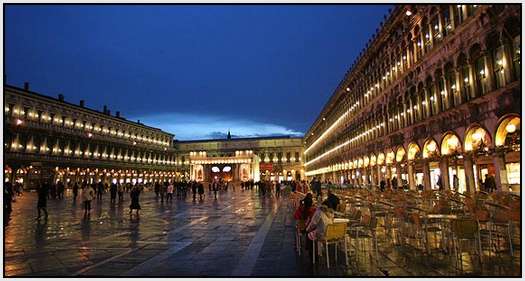|
Perpetually packed by day with people and fluttering pigeons, it can be magical at night, especially in winter, when mists swirl around the lamp posts and the Campanile.

If you face the basilica from in front of the Correr Museum, you'll notice that rather than being a strict rectangle, this square opens wider at the basilica end, creating the illusion that it's even larger than it is.
The Piazza was paved in the late 13th century with bricks laid in a herringbone pattern. Bands of light stone ran parallel to the long axis of the main piazza. These lines were probably used to help set up market stalls and in organizing frequent ceremonial processions. This original pavement design can be seen in paintings of the late Middle Ages and through the Renaissance, such as Gentile Bellini's Procession in Piazza San Marco of 1496.
On your left, the long, arcaded building is the Procuratie Vecchie, built in the early 16th century as offices and residences for the powerful magistrates of San Marco. On your right is the Procuratie Nuove, built 500 years later in a more grandiose classical style.
It was originally planned by Venice's great Renaissance architect, Sansovino, to carry on the look of his Libreria Sansoviniana (Sansovinian Library), but he died before construction on the Nuove had begun. Vincenzo Scamozzi (circa 1552-1616), a neoclassicist pupil of Andrea Palladio (1508-80), completed the design and construction. Still later, the Procuratie Nuove was modified by architect Baldassare Longhena (1598-1682), one of Venice's baroque masters.
When Napoleon entered Venice with his soldiers in 1797, he called Piazza San Marco "the world's most beautiful drawing room" and promptly gave orders to redecorate it. His architects demolished a 16th-century church with a Sansovino facade in order to build the Ala Napoleonica (Napoleonic Wing), or Fabbrica Nuova (New Building), which linked the two 16th-century procuratie and effectively encircled the piazza.
Piazzetta San Marco, the "little square" leading from Piazza San Marco to the waters of Bacino San Marco (St. Mark's Basin), is a landing that was once the grand entryway to the Republic. It's distinguished by two columns towering above the waterfront.
One is topped by the winged lion, a traditional emblem of St. Mark that became the symbol of Venice itself; the other supports St. Theodore, the city's first patron, along with his dragon. Between these columns the Republic traditionally executed convicts.
It takes a full day to take in everything on the piazza thoroughly; so if time is limited you'll have to prioritize. Plan on one to two hours for the Basilica and its Pala d'Oro, Galleria, and Museo Marciano. You'll want at least two hours to appreciate the Palazzo Ducale. Do take time to enjoy the piazza itself from a cafe table, or on a clear day, from atop the Campanile.
source: here
|


 Dyscario Feed
Dyscario Feed